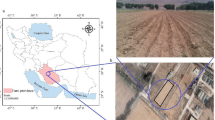Abstract
Commercial performance evaluations of surface irrigation are commonly conducted using infiltration functions obtained at a single inflow rate. However, evaluations of alternative irrigation management (e.g. flow rate, cut-off strategy) and design (e.g. field length) options using simulation models often rely on this single measured infiltration function, raising concerns over the accuracy of the predicted performance improvements. Measured field data obtained from 12 combinations of inflow rate and slope over two irrigations were used to investigate the accuracy of simulated surface irrigation performance due to changes in the infiltration. Substantial errors in performance prediction were identified due to (a) infiltration differences at various inflow rates and slopes and (b) the method of specifying the irrigation cut-off. Where the irrigation cut-off at various inflow rates was specified as a fixed time identified from simulations using the infiltration measured at a single inflow rate, then the predicted application efficiency was generally well correlated with the application efficiency measured under field conditions at the various inflow rates. However, the predictions of distribution uniformity (DU) were poor. Conversely, specifying the irrigation cut-off as a function of water advance distance resulted in adequate predictions of DU but poor predictions of application efficiency. Adjusting the infiltration function for the change in wetted perimeter at different inflow rates improved the accuracy of the performance predictions and substantially reduced the error in performance prediction associated with the cut-off recommendation strategy.







Similar content being viewed by others
References
Alvarez RAJ (2003) Estimation of advance and infiltration equations in furrow irrigation for untested discharges. Agric Water Manag 60:227–239
ASAE (2003) Evaluation of furrows. ASAE Standard EP419. American Society of Agricultural Engineers, St. Joseph, MI
Camacho E, Perez-Lucena C, Roldan-Canas J, Alcaide M (1997) IPE: model for management and control of furrow irrigation in real time. J Irrig Drain Eng 123:264–269
Enciso-Medina J, Martin D, Einsenhaur D (1998) Infiltration model for furrow irrigation. J Irrig Drain Eng ASCE 124(2):73–80
Gillies MH, Smith RJ (2005) Infiltration parameters from surface irrigation advance and run off data. Irrig Sci 24:25–35
Holzapfel EA, Zuniga C, Jara J, Marino M, Paredes J, Billib M (2004) Infiltration parameters for furrow irrigation. Agric Water Manag 68:19–32
Khatri KL, Smith RJ (2006) Real-time prediction of soil infiltration characteristics for the management of furrow irrigation. Irrig Sci 25:33–43
Mailhol JC, Ruelle P, Povova Z (2005) Simulation of furrow irrigation practices (SOFIP): a field scale modelling of water management and crop yield for furrow irrigation. Irrig Sci 24:37–48
McClymont DJ, Smith RJ (1996) Infiltration parameters from the optimisation on furrow irrigation advance data. Irrig Sci 17:15–22
McClymont DJ, Raine SR, Smith RJ (1996) The prediction of furrow irrigation performance using the surface irrigation model SIRMOD. In: Proceedings of the 13th conference, Irrigation Association of Australia, Adelaide, 14–16 May 1996, 10pp
Mwatha S, Gichuki FN (2000) Evaluation of the furrow irrigation system in the Bura Scheme. In: Land and water management in Kenya: towards sustainable land use. Proceedings of the fourth national workshop, soil and water conservation branch, ministry of agriculture and rural development and department of agricultural engineering, University of Nairobi, Nairobi
Oyonarte NA, Mateos L, Palomo MJ (2002) Infiltration variability in furrow irrigation. J Irrig Drain Eng 128(1):26–33
Pereira LS, Trout TJ (1999) Irrigation methods. CIGR Handbook of Agricultural Engineering, Michigan. Am Soc Agric Eng 1:297–379
Raghuvanshi NS, Wallender WW (1997) Economic optimization of furrow irrigation. J Irrig Drain Eng 123(5):377–385
Raine SR, McClymont DJ, Smith RJ (1997) The development of guidelines for surface irrigation in areas with variable infiltration. Proc Aust Soc Sugar Technol 19:293–301
Raine SR, Smith RJ, McClymont DJ (1998) The effect of variable infiltration on design and management guidelines for surface irrigation. In: Proceedings of the national soils conference. Australian Society of Soil Science Inc., Brisbane, 27–29 April 1998, pp 311–317
Raine SR, Purcell J, Schmidt E (2005) Improving whole farm and infield irrigation efficiencies using IrrimateTM tools. In: Irrigation 2005: restoring the balance. Proceedings of the national conference, Irrigation Association of Australia, Townsville, 17–19 May 2005, 5 pp
Rasoulzadeh A, Sepaskhah AR (2003) Scaled infiltration equations for furrow irrigation. Biosyst Eng 86(3):375–383
Schmitz GH (1993) Transient infiltration from cavities. I. Theory. J Irrig Drain Eng ASCE 119(3):443–457
Schwankl L, Raghuvanshi NS, Wallender WW (2000) Furrow irrigation performance under spatially varying conditions. J Irrig Drain Eng 126(6):355–361
Smith RJ, Raine SR, Minkevich J (2005) Irrigation application efficiency under surface irrigated cotton. Agric Water Manag 71:117–130
Strelkoff TM, Souza F (1984) Modelling effect of depth on furrow infiltration. J Irrig Drain Eng 110(4):375
Walker WR (2001) SIRMOD II—Surface irrigation simulation, evaluation and design. User’s guide and technical documentation. Utah State University, Logan, UT
Walker WR, Skogerboe GV (1987) Surface irrigation: theory and practice. Prentice-Hall Inc., Englewood Cliffs, NJ
Zerihun D, Feyen J, Reddey JM (1996) Sensitivity analysis of furrow irrigation parameters. J Irrig Drain Eng ASCE 122(1):49–57
Acknowledgement
The data used in this research was collected by Mwatha and Gichuki (2000) and is greatly appreciated.
Author information
Authors and Affiliations
Corresponding author
Additional information
Communicated by T. Trooien.
Rights and permissions
About this article
Cite this article
Langat, P.K., Raine, S.R. & Smith, R.J. Errors in predicting furrow irrigation performance using single measures of infiltration. Irrig Sci 25, 339–349 (2007). https://doi.org/10.1007/s00271-006-0049-5
Received:
Accepted:
Published:
Issue Date:
DOI: https://doi.org/10.1007/s00271-006-0049-5




